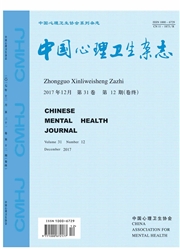

 中文摘要:
中文摘要:
目的:了解汉语阅读障碍儿童在进行字母、图片快速命名时的眼动特征与规律.方法:依ICD-10诊断标准,从儿童发育行为门诊诊断遴选阅读障碍儿童20名,并按年龄、性别、年级匹配20例正常儿童为对照组.对他们进行颜色、数字、字母和图片快速命名测试,记录命名反应时间;采用Eyelink 2High-Speed Eye Tracker眼动仪记录图片、字母快速命名时的眼动数据,比较两组儿童平均注视时间,平均眼跳幅度,注视次数,眼跳次数的差异.结果:SRD组儿童颜色、数字、字母和图片的快速命名时间均长于对照组(44.9±16.1/28.5±3.9,P<0.001;22.3±6.5/16.8±4.3,P=0.001;58.1±32.3/33.1±9.0,P=0.001;54.2±20.4,41.3±7.0,P=0.003).在字母快速命名中,SRD儿童的平均注视时间延长(342.8±64.2/309.7±42.8,P=0.038),注视次数和眼跳次数增多(126.1±60.1/92.9±21.5;149.4±78.8/95.2±21.5,P=0.011、0.003);在图片快速命名中,SRD儿童的平均眼跳幅度减小(2.9±0.6/3.7±1.0,P=0.10),注视次数和眼跳次数增多(118.0±52.2/98.9±20.3;137.8±58.9/106.9±19.2,P=0.039、0.016).结论:汉语SRD儿童存在快速命名障碍,在快速命名中存在异常的眼动模式,可能反映了其视觉空间和视觉注意缺陷.
 英文摘要:
英文摘要:
Objective: To study the characteristic and regulation of eye movements in Chinese children with reading disability during letter and picture rapid naming test. Methods: 20 children (mean age 10. 2 years, 14 male, 3 female) diagnosed as specific reading disability according to the criteria defined by ICD - 10 and 20 normal reading children matched by age and gender were investigated. All the subjects carried on color, digital, letter and picture rapid naming test. The naming time, average fixation duration, average saccade amplitude, fixation counts and saccade counts were compared between the two groups. Results: The SRD children spend more time in color, digital, letter and picture rapid naming test ( 44.9 ± 16. 1/28. 5 ± 3.9, P 〈 0. 001 ; 22. 3 ± 6. 5/16. 8 ± 4.3, P = 0. 001 ; 58. 1 ± 32. 3/33. 1 ± 9. 0, P = 0. 001 ; 54. 2 ± 20. 4, 41.3 ± 7. 0, P = 0. 003 ) . In letter rapid naming, the SRD children had longer average fixation duration ( 342. 8 ± 64. 2/309. 7 ± 42. 8, P = 0. 038 ) and more fixation counts and saccade counts ( 126. 1 ± 60. 1/92. 9 ± 21.5, P = 0. 011 ; 149. 4 ± 78.8/95. 2 ± 21.5, P = 0. 003 ) . In picture rapid naming, the SRD children have smaller saccade amplitude ( 2.9 ± 0. 6/3. 7 ± 1.0, P = 0. 010 ), more fixation counts and saccade counts (118.0 ± 52.2/98.9 ± 20.3, P = 0.039; 137.8 ± 58.9/106.9 ± 19.2, P = 0.016) . Conclusion: Chinese SRD children have rapid naming disorder and abnormal eye movement model in rapid naming tasks which may reveal their visual-spatial and visual-attention deficit.
 同期刊论文项目
同期刊论文项目
 同项目期刊论文
同项目期刊论文
 期刊信息
期刊信息
